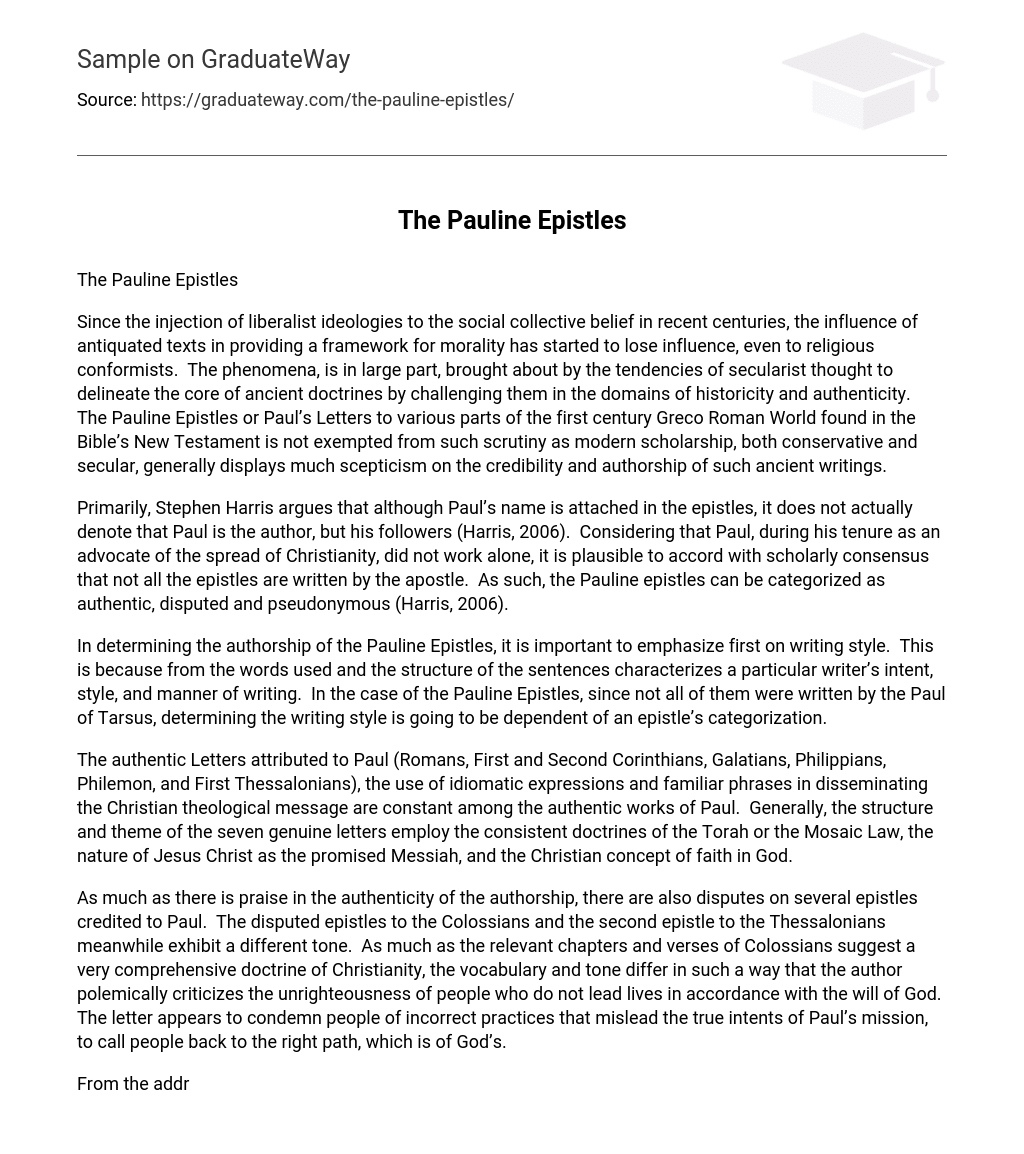Since the injection of liberalist ideologies to the social collective belief in recent centuries, the influence of antiquated texts in providing a framework for morality has started to lose influence, even to religious conformists. The phenomena, is in large part, brought about by the tendencies of secularist thought to delineate the core of ancient doctrines by challenging them in the domains of historicity and authenticity. The Pauline Epistles or Paul’s Letters to various parts of the first century Greco Roman World found in the Bible’s New Testament is not exempted from such scrutiny as modern scholarship, both conservative and secular, generally displays much scepticism on the credibility and authorship of such ancient writings.
Primarily, Stephen Harris argues that although Paul’s name is attached in the epistles, it does not actually denote that Paul is the author, but his followers (Harris, 2006). Considering that Paul, during his tenure as an advocate of the spread of Christianity, did not work alone, it is plausible to accord with scholarly consensus that not all the epistles are written by the apostle. As such, the Pauline epistles can be categorized as authentic, disputed and pseudonymous (Harris, 2006).
In determining the authorship of the Pauline Epistles, it is important to emphasize first on writing style. This is because from the words used and the structure of the sentences characterizes a particular writer’s intent, style, and manner of writing. In the case of the Pauline Epistles, since not all of them were written by the Paul of Tarsus, determining the writing style is going to be dependent of an epistle’s categorization.
The authentic Letters attributed to Paul (Romans, First and Second Corinthians, Galatians, Philippians, Philemon, and First Thessalonians), the use of idiomatic expressions and familiar phrases in disseminating the Christian theological message are constant among the authentic works of Paul. Generally, the structure and theme of the seven genuine letters employ the consistent doctrines of the Torah or the Mosaic Law, the nature of Jesus Christ as the promised Messiah, and the Christian concept of faith in God.
As much as there is praise in the authenticity of the authorship, there are also disputes on several epistles credited to Paul. The disputed epistles to the Colossians and the second epistle to the Thessalonians meanwhile exhibit a different tone. As much as the relevant chapters and verses of Colossians suggest a very comprehensive doctrine of Christianity, the vocabulary and tone differ in such a way that the author polemically criticizes the unrighteousness of people who do not lead lives in accordance with the will of God. The letter appears to condemn people of incorrect practices that mislead the true intents of Paul’s mission, to call people back to the right path, which is of God’s.
From the addressees of the epistles alone, the pseudonymous epistles appear to have been written to address individual people, namely Timothy and Titus (Harris, 2006). .But what is more apparent in the three epistles is that they give a more personal feel as there is a form of brotherly compassion to be felt in the words used and the verse constructions. Moreover, the elements of language and the mood of the letters suggest a departure from the straightforward preaching and extensive manifestation of faith found in the authentic Pauline epistles.
Paul’s letters to the Thessalonians hands out a personal as the contents of the first letter entails Paul primarily expressing his gratitude to the people of Thessalonica for the warm acceptance of the word of God into their hearts. Also, in 1 Thessalonians 5:1-11 (New International Version), Paul’s first epistle to the Thessalonians expounds Paul’s extensive apologies for the false insinuation of the impending second coming of Jesus indicated in 1 Thessalonians 4:13-18 (Harris, 2006). The second letter appears to be an update of Paul’s thought considering that it mainly involved instructions and doctrines complementing previous Pauline doctrines such as the second coming of Christ; prevalent scholarly belief is that an apostle wrote the letter to expound Paul’s established teachings in Thessalonica (Harris, 2006).
Paul’s second letter to the Corinthians gives a positive notion regarding another visit as the apostle expresses compassion towards the people of Corinth. Paul exhibited his feelings for the complexities of the state of affairs in Corinth and felt assaulted by the Corinthian questioning of his authority as a servant of God. The sudden change of mood beginning in the 10th chapter to strengthen the warning implications found in the first 9 chapters.
Apart from the doctrines of living the examples set forth by Christ, Paul also addresses how both genders should establish themselves in the ideal Christian way. In 1 Corinthians 11 Paul speaks of the duties of women as women, as the creation of God, and not as human beings in general. Paul implies that women should submit to a patriarchal norm citing the concept of creation wherein women came from man. In 1 Corinthians 7 Paul discusses the how deep the bond of marriage goes including the duties of men and women when it comes to matrimonial bonds. Likewise, the Titus one expands the context of how a husband and a wife should function in a marital relationship.
Ultimately, Paul’s teaching on the concept of marriage conforms to the patriarchal norms established by societies, both Christian and non-Christian over the centuries. Grounding the framework of his teaching from the examples set out by Christ, Paul seems to have forgotten that women are like men, with feelings and emotions that get hurt and violated. Although there are differences, and to some extent, contradictions between 1 Corinthians 7 and Titus 1 in terms of context, Paul seems to put more weight on the supremacy of man in a relationship and as a dominant being of God’s creation.
References
Harris, Stephen. (2006). Understanding the Bible. New York: McGraw-Gill Publishers.





